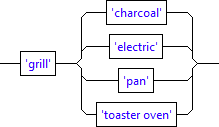Problem statement
There are many different ways to obtain nutrition. The ways explained in this book are intended to solve the following constrained optimization problem: "Maximize food quality and dining experience per calorie consumed while minimizing the shopping/cooking active time and budget."
In other words we want our food be healthy and tasty while spending minimum active time and money on food provisioning and preparation. Active time means the time which requires human involvement. For example, some sous vide recipes take several hours or even days, but their active time is just several minutes - put the food item in, set time and temperature, and then take the food item out when it is ready.
The cooking approaches described here attempt to minimize active time in total and also to spread it over the calendar time. It also attempts to minimize the intensity of active time, or mental effort, i.e. the number of decisions to make and the number of things to keep in mind. Software developers have enough of cognitive load during their working hours.
Cooking grammar
Cooking described in this book consist from a series of steps, pretty much as a computer program. Therefore, we will use "cooking grammar" to describe the process:
nutrition: shop prepare 'consume';
shop: costco | fishermans_dock;
costco: 'Costco' costco_food;
costco_food: steak | 'chicken' | lamb | 'corvina' | pork;
steak : ('tenderloin' | 'strip') 'steak';
lamb: 'lamb' ('rack' | 'chops' | 'leg');
pork: 'pork' 'ribs';
fishermans_dock: 'Fisherman Dock' fd_food;
fd_food: 'salmon' | 'shrimp';
prepare: step*;
step: 'season' | grill | 'bag' | 'freeze' | sous_vide;
grill: 'grill' ('charcoal' | 'electric' | 'pan' | 'toaster oven');
sous_vide: 'bag' 'freeze'? 'sous_vide';
The full grammar project is available here - https://github.com/pvlasov/northeast-florida-geek-grilling-and-sous-vide/cooking-grammar.
nutrition

This is the start rule of our grammar. The nutrition process includes provisioning of raw food, which in this book is shopping, food preparation and eventually consumption.
shop

This book describes shopping in Costco and Fisherman's dock. In author's opinion these food stores provide good balance between food quality, variety and price.
Costco
Costco has a vide variety of meats, but this book covers only some of them and shown below.

Costco food

Steak

Lamb

Pork

Fisherman's dock
Fisherman's Dock also carries a wide variety of seafood, but this book covers only the whole salmon and headed shrimp.
Filleted salmon and headless shrimp is also available in Costco.


prepare
Food preparation contains several steps which can be sequenced in different combinations. Some steps such as cutting, thawing, and fridging are implicit due to their short active time and/or low mental load.




Generally speaking, all steps are optional, e.g. some people slice and eat raw salmon. Examples of single-step cooking include:
- Grilling without seasoning - to feel the taste of the meat.
- Sashimi - salmon with wasabi and soy sauce.
Some constraings are not explicitly explained in the grammar that the steps shall not repeat, such as:
- Steps shall not repeat.
- Freeze only bagged food.
- Bag only to freeze.
This simple program computed 42 step sequences with 498 variations using the constraints listed above and assuming 3 types of seasonings per each food. In this book we are going to cover some sequences which include seasoning, grilling, sous vide, and freezing:
- season, sous_vide, freeze, grill
- sous_vide, freeze, season, grill
- season, grill, sous_vide, freeze
Which, taking variations of each step and assuming 3 variations for the seasoning step, results in 36 different ways to cook.
Each of the aforementioned sequences has its own characteristics which will be explained in the following chapters.